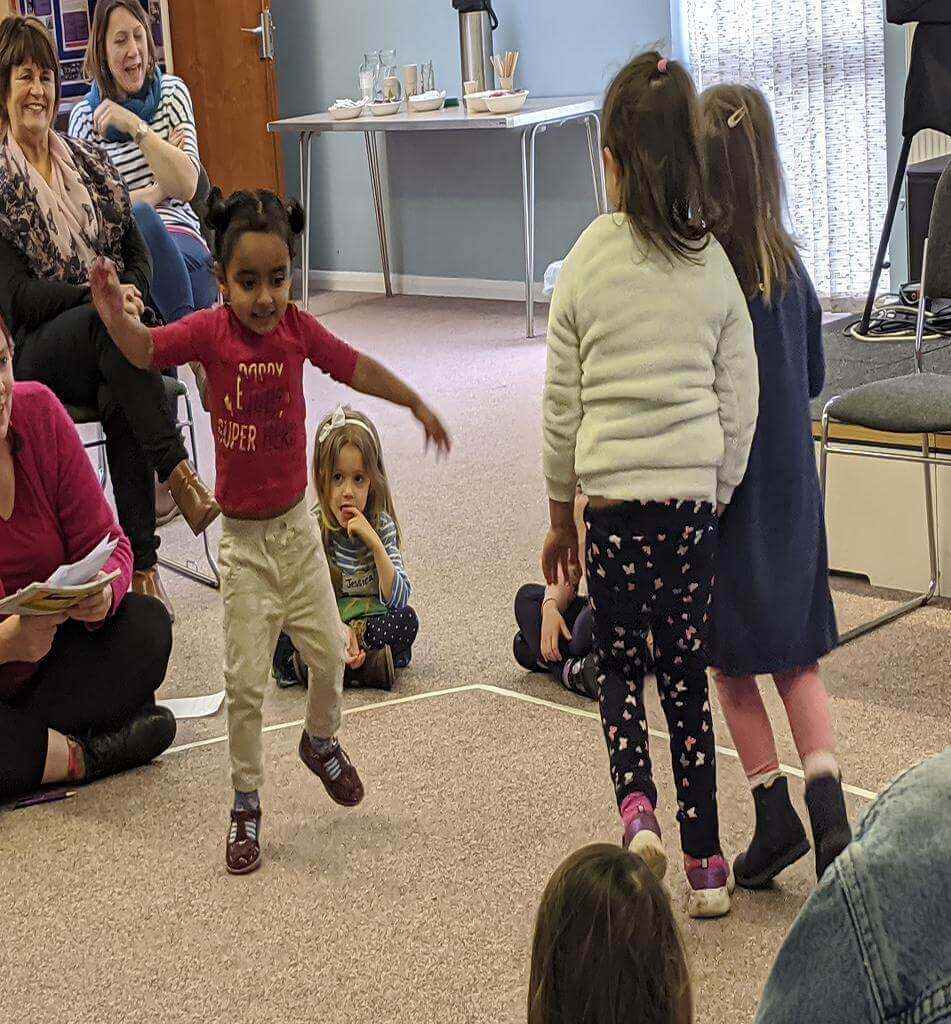‘It’s Not Fair’: Taking Turns in Helicopter Stories

“It’s not fair,” said Melissa. “I want Ruby to be in my story, not Amanda.”
“When we do stories, we go around the stage, so everyone gets to take it in turn. That way you never know who you will get to act with,” I said, hoping that the enthusiasm in my voice would win Melissa over. It didn’t.
“That’s not fair,” repeated Melissa. “Ruby’s my friend. I want her in my story.”
“But Ruby’s already had a go. Surely it wouldn’t be fair to let Ruby in your story when it’s actually Amanda’s turn.” I pointed to where Ruby was sitting. “Ruby was the princess in Jessie’s story. Do you remember?”
Melissa looked at me, and I could almost see my words racing around her brain. She walked over to the boy sat next to Ruby.

“So what was he?” she asked.
“Jonathan was the tiger.”
“And this one,” she said, pointing to the next child.
“Nishan and Oscar made the house that the princess ran to when she escaped the tiger,” I said, grateful I could remember.
Melissa was now standing next to Amanda. “And what was she?” she asked looking at me quizzically.
“Amanda hasn’t had a go yet. It’s her turn to be the kitten in your story.”
For what felt like the longest of time, Melissa stared at me. Then she looked around the stage, at Ruby, Jonathan, Nishan and Oscar. Finally she spoke. “It’s fair,” she said. Amanda crawled onto the stage and Melissa’s story was acted out.
It took time to go through this process. To accept that Melissa wasn’t happy with the rule, and to share with her why it was in place. Melissa wanted to understand the rule, which is fair enough. When rules are imposed, we have a right to question them. But as soon as Melissa received clarity, the rule was accepted and no more questions were asked.
In Helicopter Stories, children take it in turns from their place around the stage. The author choses which character they want to be, it’s their story, it is only fair they get to cast themselves. But they CANNOT choose the other actors. This ensures fairness.
When Choosing Happens

I once visited a school where choosing happened. I watched as each child who told a story chose who would act alongside them. “Joby can be the tiger, Michael will be the lion, Jamal will be the king.” As this casting took place I saw how the other children sat up straight, staring at the storyteller, desperate to be the name that was called. I also saw one boy, Timmy, put his hand up for every role. “Me, please. Me.” He was never picked.
After watching the session for a while, I asked the teacher if I could show the class how I do Helicopter Stories. Thankfully she agreed. I told the children that I was going to do something with them that was similar to what they had been doing, but in some ways a bit different. I then introduced the approach, sharing a story that a child had once told me. In the story there was a girl walking through the forest and a monster appears.
Going around the stage taking it in turn, I asked the child sitting next to me to be the girl walking through the forest. Then I counted out seven children. “1, 2, 3, 4, 5, 6, 7 – can you pretend to be the trees in the forest. Show me how you would stand if you were a tree?” Why did I have seven trees? I might not always have that many. But the boy sitting next to the child who played the seventh tree was Timmy, and I wanted him to have an exciting role.
Timmy’s face when he saw he had the opportunity to play the monster was amazing. He stood up and became the character. His was the most monstrous of monsters. It was laced with six months of asking to be in someone else’s story and of being refused. This was an Oscar winning rendition of the part of the Monster.
Next, we acted out a few more stories, and everyone had a turn. Afterwards the children agreed that they would try acting out their stories in this way, for one month and then see which way they preferred.
Finding a Way into the Other Children’s Stories

A few days later I received an email from the teacher. She told me that Timmy had been struggling to settle at school. He hadn’t made any friends. But yesterday, he had his first invite for tea with another child in his class. Timmy had found his way into the other children’s stories. But then who wouldn’t want to be friends with a child who can play a monster with such conviction. On top of that, a month later the children decided to continue casting the actors by going around the stage. Having used this way of selecting actors all over the world, I have seen how successful it is at connecting a group of children to the stories of their peers. Gender roles are blurred and the classroom works like a Theatre Troupe – creating the scripts, acting the roles and being the audience, learning from each other as they grow as storytellers.






Responses